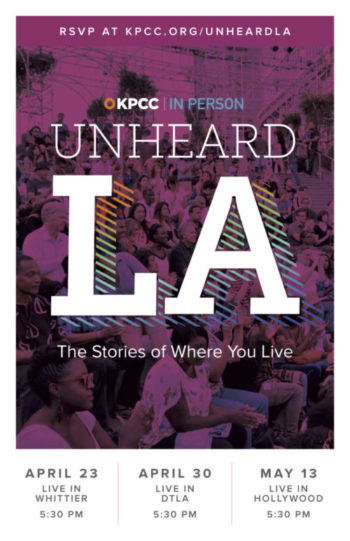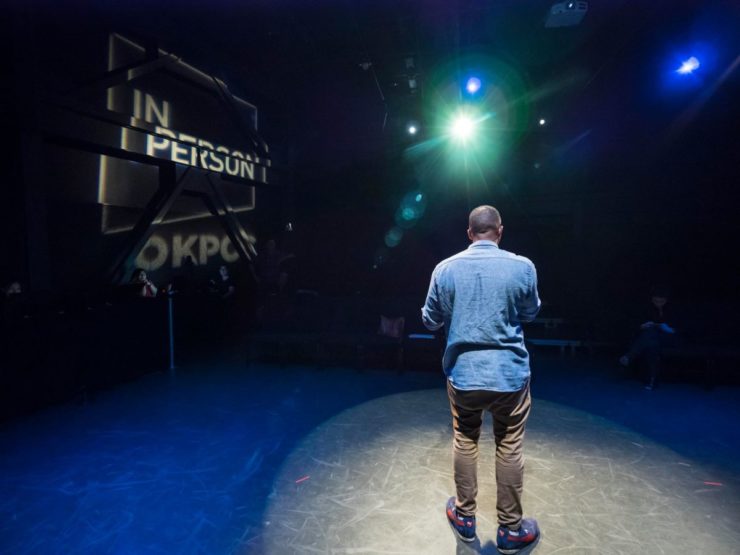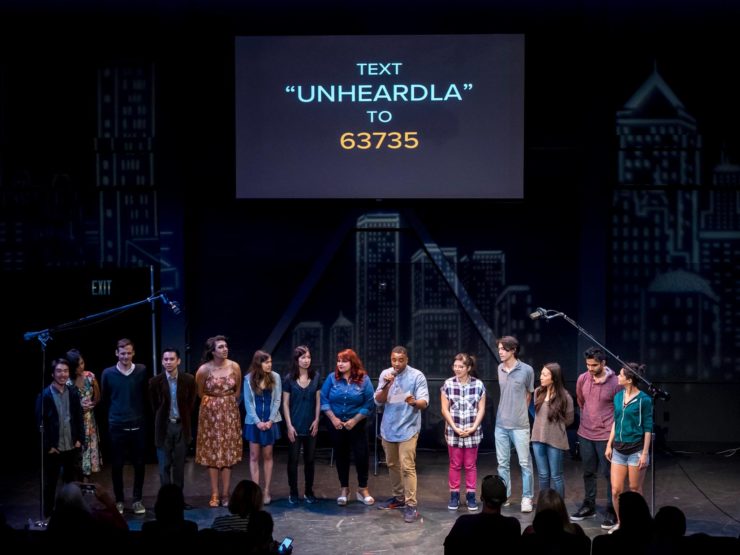KPCC In Person is the events and engagement team for KPCC, Southern California Public Radio. Unlike many media organizations, our live events team is embedded in our newsroom. Through our work, we meet fascinating people who make Southern California a diverse, dynamic, and complicated place. But their stories rarely surface in media. Untold and unheard.

Fueled by our public service mission and with generous initial support form the California Wellness Foundation, we launched “Unheard L.A.—the stories of where you live,” a community-driven storytelling series to celebrate life in Southern California.
The pilot series consisted of three live shows in three unique venues around greater Los Angeles: a college campus in Whittier, an arts center in downtown Los Angeles’s Skid Row, and a playhouse in Hollywood affiliated with a nonprofit known for serving impoverished children. Each show featured distinct lineups of community members sharing first-person experiences through spoken word, music, poetry, improvisation, and other forms.
Our goals were to create a platform for storytellers as a catalyst for connection. We invited participants and attendees to join us for a mixer following the show to interact with one another. Everyone was encouraged to share their own stories and not leave that night “unheard.”
The results have been palpable: Three full houses, with more than 80 percent of the RSVPs coming from people interested in attending a KPCC In Person event for the first time. The audiences were younger and more diverse, and the Facebook videos of the shows have reached more than 76,000 people (a record for our team’s Facebook page). Some of the stories have been featured on two of our daily radio programs “AirTalk” and “Take Two.”
Here are some lessons we learned along the way.
Meet people where they are.
The process began with an invitation to community members to share a story about themselves or their community. We focused on reaching out to folks beyond our existing audience and familiar networks, and every story was sourced and developed in collaboration with them. We engaged people using a variety of channels: We launched a Public Insight Network query in English and Spanish, printed thousands of postcards, and distributed them at county library branches, invited people to submit via text message and community bulletin boards, and reached out to hundreds of new people and those we’ve met through in-person engagement work. More than 250 people submitted their stories.
Embrace ambiguity. Mean it.
We were intentionally vague in the way we designed the query; we didn’t want to be prescriptive or exclude people from participating because they didn’t see themselves as storytellers. We embraced ambiguity, which meant responses came in that were not fully developed. And we were OK with that. Among the pitches: opera and social media, immigration and mental illness, identity and parking. We read every submission, following up on leads, investing the time and energy needed to understand what people saw as their respective communities, what they hoped to convey, and how we might work together develop their pieces. Eventually, we settled on a short list of final candidates and continued to develop the individual pieces: stories that were reflective of lived experiences without ever asking an individual to be representative for a whole community.

Design matters. So does buy-in.
As submissions came in, we knew we were on to something. The stories revealed new layers to life in Southern California; some were funny, some were beautiful, some were heartbreaking. But how could we ensure people would come to the shows and get to feel that connection with the storytellers and their words? We worked closely with our product design team to develop a strong visual identity for the “Unheard L.A.” series, one that carried through all promotion and into the individual shows.
Working with veteran photographer and long-time collaborator Bill Youngblood, we took candid black-and-white portraits of storytellers that we paired with quotes to live-tweet during shows. Ahead of each event, he also took photos of the venue and neighborhood that we weaved into the production to visually reinforce the importance and power of place. As excitement built around the project externally, we also saw greater buy-in internally. We promoted “Unheard L.A.” on-air, online, and through engagement partners and coverage by other media.
Keep it real.
Many of the “Unheard L.A.” storytellers had never been onstage before. While we worked to get them and their pieces ready for the stage, our focus was on substance rather than delivery, on people rather than performance. This process was a powerful learning experience for our team, as we were reminded of the importance of trusting the community we serve; that understanding became part of the foundation of “Unheard L.A.” Among the stories shared so far are experiences with mental illness and self-harming, growing up as an undocumented immigrant, searching for cheap Zumba classes in Koreatown, and being seen as a “perpetual foreigner.” It wasn’t the polish of the pieces but rather the authenticity of the experiences that made the stories resonate. In the specificity of each story, we—and our audiences—found common ground.
With our commitment to being “of the community,” we felt it crucial to have an “Unheard L.A.” host who knows and loves Los Angeles while, at the same time, is aware of its complicated imperfections. For us, that person was actor, director, educator, and Watts native Bruce Lemon.
So, what’s next?
The pilot phase of “Unheard L.A.” wrapped in May. Due to the overwhelming buy-in from both the community and our colleagues, we are committed to continuing the series and are currently in the midst of determining the scale and scope of future iterations, including the exploration of more regular multiplatform delivery.
“Unheard L.A.” has served as a compelling reminder that through listening and trusting the communities we aim to serve, we can not only collaborate on meaningful, immersive content but grow our audience, reach, and impact. We can also strengthen our journalism through more diverse sourcing across platforms, better reflect one of the most diverse metropolises in the nation, and tell a more nuanced and in-depth story of our region.
To share your “Unheard L.A.” story, visit kpcc.org/network.



